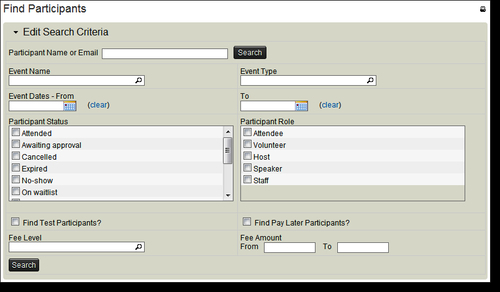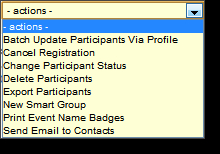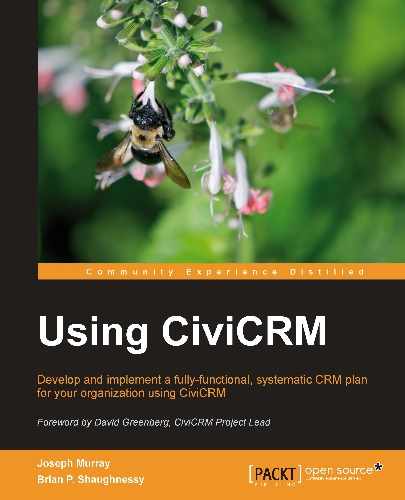In the last section, we worked with an individual contact record to see how the registration is created with an associated contribution record. In this section, we will begin working with multiple participant records.
One of the most important things for you as an event manager is the ability to quickly see how many people have registered for a given event. CiviCRM provides you with a snapshot to these details on the Events | Dashboard page.
Similar to other areas of CiviCRM, the Dashboard provides a snapshot into key data in a summarized fashion. For events, this consists of a listing of upcoming events with registrant counts broken down into various categories, and a list of recent registrations received.
The registrant counts are very useful and bear some explanation. Review the following screenshot:

CiviCRM helps you understand your participant records by breaking them down into categories. We begin with the number of Counted registrants, in contrast to those Not Counted. Counted participants include those who have registered, including both those who have paid and those who will pay later. Not Counted is broken up by status and role. By default, registrants with a status of no-show, cancelled, pending from incomplete transaction, on waitlist, rejected, and expired, will all be excluded from the registrant count. Why? This is because they are not expected to attend or are confirmed to not have attended. In a similar way, participant roles may be configured to be included or excluded from the total counts. In the example we saw earlier, we had created a participant role entitled "Staff" which should not be included in the count.
Settings for the participant statuses and roles can be configured through Administer | CiviEvent, and were discussed earlier in this chapter. What we see in this section is the impact of those settings and how they are used to help you understand the nature of your participants.
The Registered, Pending from Pay Later, and Cancelled counts you see in the screenshot reflect the various participant statuses represented by the records. If other statuses were present, they would be listed as well.
Note that each of these counts is a live hyperlink; selecting the link displays the relevant registrants in that count. This is, by far, the fastest way to view and work with a segment of your participant records.
While the dashboard provides a quick window into a single event, you will undoubtedly want to search for records based on more refined criteria or across multiple events. We do this through Events | Find Participants, as shown in the following screenshot:

The fields available through this tool are fairly self-explanatory. You have options to search within a single event, across multiple events within an event type category, by date ranges, or fee ranges. The search fields are restrictive; all criteria must be matched in order to return results. Entering a large number of criteria will result in a smaller number of records returned. The two exceptions are the multi-select fields, Participant Status, and Participant Role. Multiple selections within that field are inclusive, though its interaction with other fields remains restrictive.
Similar to CiviCRM's other search tools, you may take action on bulk records after running a search. First select all records or choose selected records and then initiate your action from the drop-down menu.

Most of these are standard options we will not review. Take note of the Change Participant Status option, which is unique to events, and the Print Event Name Badges option. You will use the latter to generate bulk name badges and follows steps similar to what was noted earlier—you select the format for your name badges, and then trigger the creation of a PDF file, which can be used for printing.
Note
Recall that component searches will retrieve the associated related records, and not the contact records, in their results. This means that a single contact may be duplicated if they have multiple event registrations matching the selected criteria. Further, the export tool provides options for including details about the related records; in this case, the participant details, as that is the "lens" through which the data is retrieved.
Though this search tool will generally fill most of your needs for isolating records, you may find one particular area where it falls short, namely, the handling of price set fields. Price set fees are tricky because they result in a series of sub-fields associated with a single registration record. When searching and exporting registrations, it becomes difficult to effectively search on and export that data within the context of this form.
To overcome this, CiviCRM ships with a custom search that will break down your event by price set fields. To access it, visit Search... | Custom Searches…. Click on the Custom Searches... menu item to view the full list of available tools (the submenu only includes a small selection of available tools). From this list, choose Price Set Details for Event Participants. Select an event and trigger the search to return a grid-based breakdown of participants by their price set fees.
A second custom search may also be of value: Event Aggregate. This search displays registration fee summary calculations for events. More robust reporting tools that we will review shortly may prove more useful as this report is somewhat limited.
Before wrapping up our discussion of event functionality, let's look at how the reporting tools can help you share the story of your event's success. Though a full discussion of reporting tools is covered later in this book (Chapter 12, Telling Your Story: Building Reports), we will briefly review the three event-specific reports available to you.
CiviCRM ships with four reports that involve event records, two of which are based on the same report template. From the Reports menu, they are as follows:
- Event Participant Report (List)
- Event Income Report (Summary)
- Event Income Report (Detail)
- Attendee List
The Event Participant Report and Attendee List are both based on the same template and basically provide options for retrieving registrants based on the role, status, event(s), event type, or date range. It is great for generating a list of attendees for staff to keep on hand during the event, or to publish an attendee list for distribution to attendees. One of the unique things about this report is that you can include blank columns before or after the data columns. This could be used to track attendance by checking off registrants on the list as they check-in to the event or to collect other information to be imported later.
The Event Income Report (Summary) displays event income details and breaks out the participant status categories in the event. Using this report, you gain a sense of how your registrants versus cancelled or other non-counted statuses may have impacted your net income.
Event Income Report (Detail) generates a detailed breakdown of all major categories of the event, including statuses and roles, and generates counts and income totals for each line. It provides an excellent "final report" tool for your event file.
